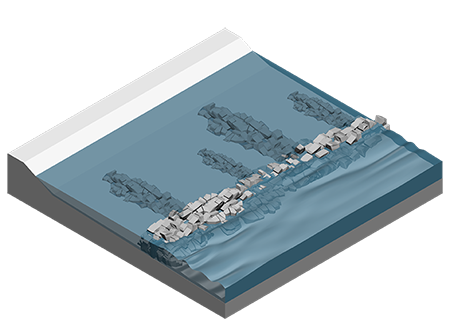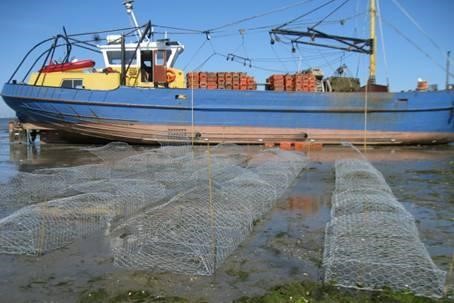Living Breakwaters
Breakwaters are offshore structures designed to limit wave energy by creating a barrier, most often underwater, between open water and the shoreline. While traditional breakwaters may be made from stone, concrete, or other building materials, a living breakwater is a breakwater that is intentionally designed to incorporate natural habitat components while still providing protection to the coastline. Living breakwaters – sometimes known as artificial reefs – incorporate natural habitat by providing opportunities for settlement and colonization by oysters or hard corals or by creating complex structural components that provide shelter and habitat for various marine and aquatic species.
Hazard Mitigation
Living breakwaters reduce the effects of storm surge and coastal erosion by absorbing wave energy during storm events. As waves break on the structure, their energy is reduced, calming waters on the shoreward side of the breakwater and reducing the direct impacts to the shoreline.
Siting Considerations
A living breakwater is first and foremost intended to serve as protection against storm surge and coastal erosion. As such, it is sited in a similar way to a traditional breakwater to provide the maximum amount of erosion and wave energy reduction possible. Depth, width, height, size, and position relative to the shoreline of the living breakwater are the major components that will determine the effectiveness of the structure.
There are external influences that need to be considered as well, such as the local influence of currents and wave action as well as the expected wave design height. In addition to determining a suitable location for a living breakwater from a storm surge protection standpoint, it is important to factor in considerations of navigation, as living breakwaters can create a potential navigational impediment in the water column.
Depending on where the living breakwater is being installed, a different mix of species can be expected to colonize it. In sub-tropical waters where coral reefs are viable, it may take as many as five years to establish a healthy, stable benthic community. In cooler waters where shellfish reefs occur, colonization may happen much more rapidly.
Selection of breakwater materials is also an important consideration as oysters in particular will not attach to every surface that is submerged. Allowable materials for artificial reefs are determined by the US Army Corps of Engineers and, often, state agencies with jurisdiction over marine and estuarine resources. Recent technological advancements have resulted in new kinds of more porous concrete and reef substrate designs that create structural complexity, which has increased the likelihood of successful colonization of these reefs by oysters or corals.

Costs
Material costs will dominate the budget of any living breakwaters project. Costs will vary considerably as materials may range from using previously harvested oyster shells (clutch), to pre-formed concrete structures (often known as reef balls), to much larger items such as sinking retired boats or large pieces of infrastructure.
In addition to the substrate, transportation and deployment costs can be significant as projects may require the use of barges and heavy equipment. There may also be a need to provide juvenile corals or oyster spat as a means to start the biological recruitment process to the reef.
The Reef Ball Foundation has put together this guidance on potential project costs.
Co-Benefits of the Strategy
Living breakwaters or artificial reefs have principally been used as a means of restoring lost habitat in the past. Healthy coral reefs and oyster reefs play a vital role in providing shelter, habitat, and food for numerous species in the nearshore environment. Some estimates have found that nearly 25% of all marine species rely on coral reefs for some aspect of their life cycle. While not quite as diverse, oyster reefs play similarly important roles in the nearshore environment. In addition to providing habitat, oyster reefs help to clean the water column. A single oyster is able to filter as much as 50 gallons of water a day, cleaning it of pollutants and nutrients thereby increasing the overall quality of the water.
In addition to the ecological benefits provided, living breakwaters can serve as economic drivers in the local economy through enhanced fishery production and recreational tourism. According to NOAA, the commercial value of coral reef based fisheries is more than $100 M annually across the United States. In Florida, approximately 70% of commercial and recreational species rely on seagrass beds during some phase of their life. In addition to providing habitat to striped bass, menhaden, and numerous other commercial species, oyster reefs provide the foundation of the oyster fishery, which produced an annual harvest in 2014 of nearly $250 M nationwide. Coral reef based tourism in the Florida Keys has been estimated to provide more than $1 B of economic activity annually.

Maintenance Considerations
Generally speaking, once these offshore areas are established they will be mostly self-sustaining. Occasional maintenance on the physical structure may be necessary, but as benthic species colonize they will provide a level of natural upkeep to the structure.
Given that living breakwaters can create a recreational attraction, care needs to be taken to make sure that oyster beds are not being harvested illegally or that corals are not being disturbed. Additionally, as these may impact navigation, regular monitoring to ensure there have been no impacts from boats is recommended.
Additional Considerations
Offshore reefs require a number of federal permits and will likely require state and local permits as well. Section 6.1, beginning on page 65 of this document has an excellent summary of the federal permits that may be required for an artificial reef.
Additional Resources
The Atlantic and Gulf States Marine Fisheries Councils produced a report entitled “Guidelines for Marine and Estuarine Artificial Reefs”. While the focus of the report is more on creating habitat, it may provide useful information in exploring the development of living breakwaters for the purposes of erosion and wave reduction.
The Reefball Foundation has compiled an extensive guide on implementing artificial reef projects. While these are primarily focused on restoration of coral reefs, the guidance is more widely applicable and the process can be used to work through the planning of a living breakwaters project.
While written for Australia and with a focus solely on corals, this guide provides a good discussion of which factors should be evaluated when considering sites for the placement of living breakwaters or artificial reefs, as well as details on most aspects of construction and management of artificial coral reefs.
The University of Florida and Collier County have developed some basic guidance for artificial reef deployment in Florida, including guidance on permitting and allowable materials.


